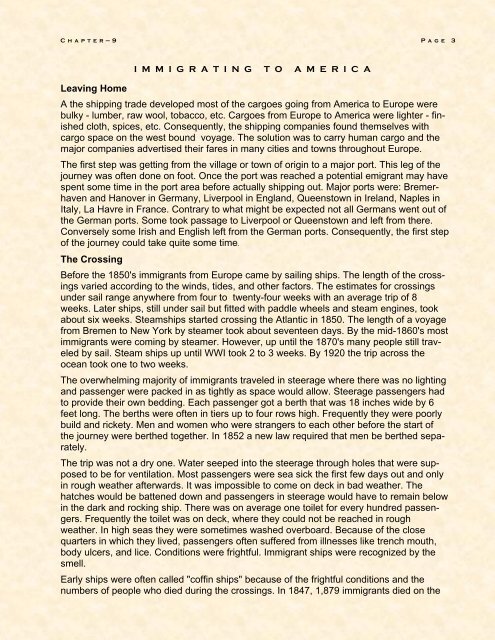Descendants of Levi Infanger - Cardello Family History
Descendants of Levi Infanger - Cardello Family History
Descendants of Levi Infanger - Cardello Family History
Create successful ePaper yourself
Turn your PDF publications into a flip-book with our unique Google optimized e-Paper software.
Chapter—9<br />
I M M I G R A T I N G T O A M E R I C A<br />
Page 3<br />
Leaving Home<br />
A the shipping trade developed most <strong>of</strong> the cargoes going from America to Europe were<br />
bulky - lumber, raw wool, tobacco, etc. Cargoes from Europe to America were lighter - finished<br />
cloth, spices, etc. Consequently, the shipping companies found themselves with<br />
cargo space on the west bound voyage. The solution was to carry human cargo and the<br />
major companies advertised their fares in many cities and towns throughout Europe.<br />
The first step was getting from the village or town <strong>of</strong> origin to a major port. This leg <strong>of</strong> the<br />
journey was <strong>of</strong>ten done on foot. Once the port was reached a potential emigrant may have<br />
spent some time in the port area before actually shipping out. Major ports were: Bremerhaven<br />
and Hanover in Germany, Liverpool in England, Queenstown in Ireland, Naples in<br />
Italy, La Havre in France. Contrary to what might be expected not all Germans went out <strong>of</strong><br />
the German ports. Some took passage to Liverpool or Queenstown and left from there.<br />
Conversely some Irish and English left from the German ports. Consequently, the first step<br />
<strong>of</strong> the journey could take quite some time.<br />
The Crossing<br />
Before the 1850's immigrants from Europe came by sailing ships. The length <strong>of</strong> the crossings<br />
varied according to the winds, tides, and other factors. The estimates for crossings<br />
under sail range anywhere from four to twenty-four weeks with an average trip <strong>of</strong> 8<br />
weeks. Later ships, still under sail but fitted with paddle wheels and steam engines, took<br />
about six weeks. Steamships started crossing the Atlantic in 1850. The length <strong>of</strong> a voyage<br />
from Bremen to New York by steamer took about seventeen days. By the mid-1860's most<br />
immigrants were coming by steamer. However, up until the 1870's many people still traveled<br />
by sail. Steam ships up until WWI took 2 to 3 weeks. By 1920 the trip across the<br />
ocean took one to two weeks.<br />
The overwhelming majority <strong>of</strong> immigrants traveled in steerage where there was no lighting<br />
and passenger were packed in as tightly as space would allow. Steerage passengers had<br />
to provide their own bedding. Each passenger got a berth that was 18 inches wide by 6<br />
feet long. The berths were <strong>of</strong>ten in tiers up to four rows high. Frequently they were poorly<br />
build and rickety. Men and women who were strangers to each other before the start <strong>of</strong><br />
the journey were berthed together. In 1852 a new law required that men be berthed separately.<br />
The trip was not a dry one. Water seeped into the steerage through holes that were supposed<br />
to be for ventilation. Most passengers were sea sick the first few days out and only<br />
in rough weather afterwards. It was impossible to come on deck in bad weather. The<br />
hatches would be battened down and passengers in steerage would have to remain below<br />
in the dark and rocking ship. There was on average one toilet for every hundred passengers.<br />
Frequently the toilet was on deck, where they could not be reached in rough<br />
weather. In high seas they were sometimes washed overboard. Because <strong>of</strong> the close<br />
quarters in which they lived, passengers <strong>of</strong>ten suffered from illnesses like trench mouth,<br />
body ulcers, and lice. Conditions were frightful. Immigrant ships were recognized by the<br />
smell.<br />
Early ships were <strong>of</strong>ten called "c<strong>of</strong>fin ships" because <strong>of</strong> the frightful conditions and the<br />
numbers <strong>of</strong> people who died during the crossings. In 1847, 1,879 immigrants died on the




